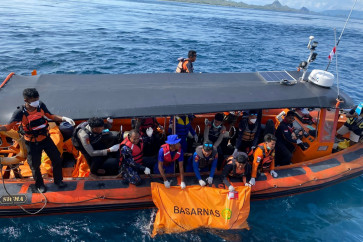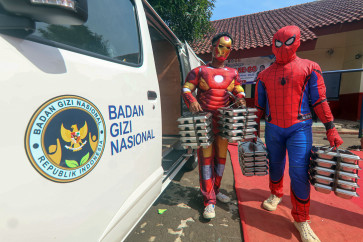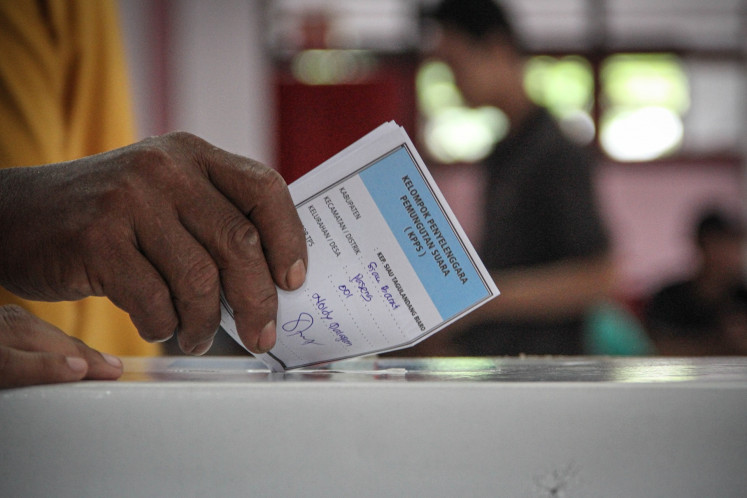Popular Reads
Top Results
Can't find what you're looking for?
View all search resultsPopular Reads
Top Results
Can't find what you're looking for?
View all search resultsMyanmar and sustainable change
Myanmar is currently going through some of the most important political transitions in its history
Change text size
Gift Premium Articles
to Anyone
M
yanmar is currently going through some of the most important political transitions in its history. The new quasi-civilian government is embarking on an ambitious reform path, which has brought with it both optimism and caution.
Positive events include the convening of an active parliament in April 2011, the release of hundreds of political prisoners in January 2012 and further more in September of the same year, the signing of ceasefire agreements with armed ethnic groups in early 2012 and largely free and fair by-elections in April 2012 in which democracy icon Aung San Suu Kyi won a seat in parliament.
Some view the reform as a genuine process lead by Thein Sein, while others are still very cautious about whether the reform will stay on track, especially given the enormous challenges and the strong military power in both politics and business. Opposition leader Suu Kyi and her political party opt to remain vigilant and maintain “healthy skepticism”. This is also true of the civil society groups in the country.
There are questions as to what are the key drivers of change in Myanmar. Some view the current reform as an inevitable option to balance the influence of China in the country.
Others perceive this as a result of internal dialectics within the country. The instrumental role of Burmese groups living in exile is to collaborate with different international advocacy movements to keep the Myanmar agenda alive in the UK, Europe and the UN.
The constructive engagement role of ASEAN to integrate Myanmar into ASEAN Economic Community (AEC) by 2015 is also viewed as another big driver.
In short, the reform path undertaken by the Myanmar government has resulted from different forces of influence both internally and externally. The path therefore seems to be irreversible.
However, the challenge ahead is to ensure that democratic ideals are put into practice to enable the creation of inclusive institutions remains valid.
In her recent visit to the US in September 2012, Suu Kyi was invited by the Asia Foundation to deliver a speech where she mentioned the importance of support from the Western world in terms of building democratic institutions, be it executive, legislative or judiciary.
While the request is valid, the genuine political reform, as to whether the military to remain in politics or not, is also worth probing.
In this sense, Myanmar might want to learn from post-military regime reform in Indonesia.
Indonesia experienced one of the cruelest military regimes in the world for 32 years before Soeharto stepped down in 1998 — as a result of the students’ revolutionary movement. Since then, the Indonesian Military (TNI) has gone through institutional reforms firstly through the abolition of military dual-function doctrine.
In the past, this doctrine allowed military to play their double role in defense and security as well as in the sociopolitical arena to promote national development and ensure political stability.
This allowed the military to actively take part in politics, as evidenced by the allocation of 75 out of 500 seats in the House of Representatives for the TNI, on top of 2,800 non-elected seats in regional and sub-regional legislatures.
Alongside the dual-function doctrine, the military also implemented a broad policy of kekaryaan (temporary duty) where active and retired military officers occupied strategic positions in national and regional government posts, up to village heads (Robinson, 2001: 235), as well as executive posts in state-owned enterprises.
The military also exerted their influence through Golkar, the government-supported party, by which the former helped the latter to win majority votes in the elections.
After the fall of Soeharto, a group of “intellectual and reform minded” generals such as Agus Widjojo, Agus Wirahadi Kusuma and Susilo Bambang Yudhoyono approached then TNI chief, Gen. Wiranto, to push for internal reform within the military.
This was influenced by public pressure as well as internally from the military to adapt to the political change post-Soeharto.
The military then adopted the so called “new paradigm”, which consisted of four key points, namely, that all times it is not always necessary for the military to be at the forefront of national politics; the military would not seek to occupy political positions, but influence decision making process; the military would exert its influence indirectly rather than directly; and the military would work in partnership with other national entities.
This is a stepping stone for further institutional reform of Indonesian military. Despite the abolition of the military’s dual-function it is well noted that the substantial reform after 14 years of reformation has yet to be successful.
Mark Dearn observes that Myanmar’s post-colonial era is characterized by the domination of the military as the key player in the state’s politics over the 62-year period since British rule ended.
The comparatively brief “parliamentary period” (1948–1962) aside — when the ruling coalition was driven by factionalism and internecine conflict plagued the nascent state — military domination has persisted under various guises through to the present day, to the extent that the Tatmadaw (military) is synonymous with the state and that Myanmar’s system of rule can be described as “praetorian”, in that military officers are the major political actors by virtue of their actual or threatened use of force.
Although the reform led by ex-general President Thein Sein since March 2011 is worth noting, there is still a big concern of military being active in politics.
There are 25 percent of non-elected military representatives in the parliament as mandated by the Constitution. Majority of parliament members are from Union Solidarity and Development Party which constitute 60 percent of the parliamentary seats. Thein Sein leads this party along with other 22 military officials.
The military officially falls under the command of the Tatmadaw, Armed Forces’ Deputy Commander-in-Chief Gen. Soe Win.
While Tatmadaw representatives have stated that it is working “synchronously under the supervision of the President”, its involvement in military skirmishes in some ethnic areas, as well as the ongoing conflict in Kachin State against presidential orders is evidence of its semi-autonomy.
As the country is opening up to the outside world and undertakes comprehensive economic and political reform, it is important that the military can buy into the reform spirit lead by the president and that international community can positively contribute to institutional reform of the military to ensure lasting and sustainable reform in Myanmar.
At regional level, Indonesian experience in military institutional reform might serve as a good example for Myanmar.
The writer is a research fellow at the Institute of Resource Governance and Social Change and is currently based in Phnom Penh, Cambodia.










